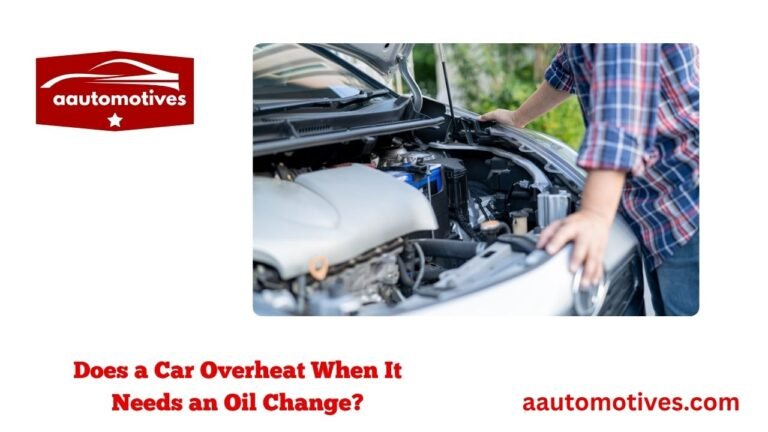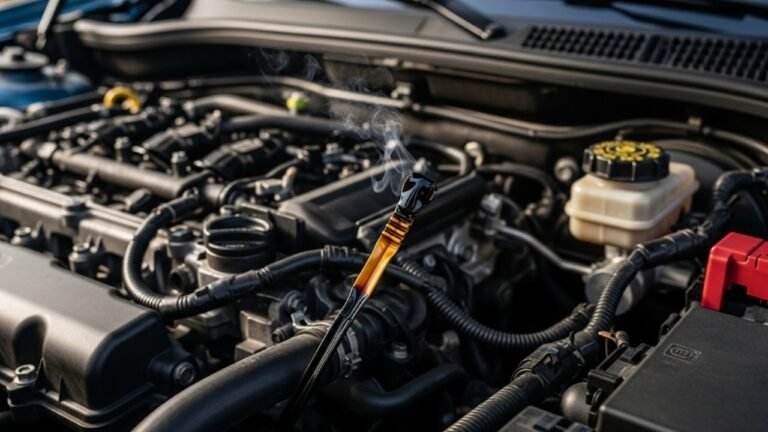Can No Oil in Car Symptoms Be This Serious? A Friendly Guide

Imagine waking up late on a Monday morning, rushing to your car, turning the key—and silence. Or worse, an awful knocking noise. That’s how it starts for many people. And often, the culprit is simple but devastating: no oil in the car.
Engine oil is like blood for your car. Without it, things go downhill fast. But here’s the tricky part—most folks don’t even know the signs until it’s too late. That’s why we’re diving deep into can no oil in car symptoms, explaining everything you need to know in simple, friendly language.
This isn’t your typical dry mechanical guide. Think of this as chatting with a friend who’s had a few car scares (I have!) and wants to make sure you don’t end up stranded or with a dead engine.
Let’s break it all down—symptoms, warnings, real-life stories, and how to prevent the damage before it eats your savings.
In This Article
- 1 What Happens When There’s No Oil in the Engine?
- 2 Most Common “Can No Oil in Car Symptoms” You Shouldn’t Miss
- 3 Quick Look: Symptoms of No Oil in Car (Table)
- 4 A Personal Story: How I Almost Ruined My Engine
- 5 Why You Might Have No Oil in Your Car (Even If You Think You Do)
- 6 How to Check If You Have No Oil in Your Car
- 7 Emergency Tips: What to Do If You’re Driving With No Oil
- 8 How to Prevent the Nightmare: Keep Your Oil in Check
- 9 DIY Oil Maintenance Tips (Even If You’re Not a Mechanic)
- 10 Expert Tip: Synthetic Oil vs Conventional Oil
- 11 Summary: Key Takeaways on No Oil in Car Symptoms
- 12 ❓ FAQs: Can No Oil in Car Symptoms Really Be This Serious?
- 12.1 1. Can a car run with no oil at all?
- 12.2 2. How often should I check my oil level?
- 12.3 3. What’s the difference between low oil and no oil?
- 12.4 4. How do I know if the knocking noise is oil-related?
- 12.5 5. Can I just top off the oil without an oil change?
- 12.6 6. Will my car still drive normally with no oil?
- 12.7 7. Can I fix engine damage from no oil?
- 12.8 8. How much does it cost to fix a car that ran with no oil?
- 13 Final Thoughts: Listen to Your Car—It Speaks
What Happens When There’s No Oil in the Engine?

Here’s what oil actually does:
-
Lubricates engine parts to reduce friction.
-
Cools down hot components.
-
Prevents corrosion by reducing exposure to oxygen and moisture.
-
Cleans the engine by trapping dirt and metal particles.
Without oil, it’s like running a marathon with no water, no shoes, and broken knees.
Result? Total engine failure.
Most Common “Can No Oil in Car Symptoms” You Shouldn’t Miss
Here comes the meat of the matter. Let’s go through real signs your car might be running without oil—and what they feel like from the driver’s seat.
1. Engine Warning Light Comes On
This is your car’s way of crying for help.
-
If the oil pressure light blinks or stays on, pull over immediately.
-
Driving with this light on means you’re playing with fire—literally.
Think of it like a fever in your body. It might seem minor at first, but it’s your engine saying “something’s wrong.”
2. Knocking or Tapping Noise from the Engine
Ever heard a metallic tick-tick-tick sound from under the hood?
-
That’s your engine’s components colliding without lubrication.
-
It’s one of the loudest can no oil in car symptoms.
This noise gets worse the longer the engine runs dry. I had this once in my old Corolla, and let me tell you—it sounded like a drummer was stuck under my hood.
3. Overheating Engine
Without oil, friction builds up. And with that, heat skyrockets.
-
Your temperature gauge may climb to the red zone.
-
You may even see steam from under the hood.
Think of it like running in the sun without water. Your body gives up—and so will your engine.
4. Burning Smell or Smoke
When there’s no oil in the car, the engine gets hotter than it should.
-
You might notice a burning oil smell.
-
Or actual smoke creeping from the hood.
It smells like metal being cooked—and trust me, it’s as bad as it sounds.
5. Poor Fuel Economy and Sluggish Performance
Without lubrication, the engine struggles more.
-
It works harder, which means it guzzles more fuel.
-
The car feels heavier and less responsive.
You’ll press the gas, but the response will feel delayed. Not fun when merging onto a highway.
6. Complete Engine Failure
This is the worst-case scenario.
-
If ignored, all the symptoms above lead to engine seizure.
-
It stops moving—just locks up.
At this point, you’re not repairing it. You’re replacing it.
A seized engine can cost anywhere between $4,000–$10,000 depending on your car.
Quick Look: Symptoms of No Oil in Car (Table)
| Symptom | What It Feels Like | Severity |
|---|---|---|
| Oil light on | Blinking red light on dash | High |
| Knocking noise | Metallic ticking or knocking | High |
| Overheating | Temp gauge spikes, steam visible | Critical |
| Burning smell | Strong burnt odor or smoke | High |
| Poor performance | Sluggish acceleration | Medium |
| Engine seizure | Car stops, won’t restart | Critical |
A Personal Story: How I Almost Ruined My Engine
I remember one summer day, I was heading to Cox’s Bazar with friends. We were singing, eating chips, having fun—until the car suddenly started shaking and smelling like something was burning.
I pulled over, opened the hood, and the heat nearly slapped me in the face. No oil in the engine.
Turns out, I hadn’t checked it in months.
That trip turned into a nightmare. Tow truck, three-day repair, and a hefty bill. I learned the hard way that can no oil in car symptoms aren’t something you ignore.
Why You Might Have No Oil in Your Car (Even If You Think You Do)
So how does this even happen? You had oil when you bought the car, right?
Here’s how it vanishes:
-
Oil leaks (you’ll often see spots on your garage floor)
-
Burning oil in older engines
-
Not changing oil often enough
-
Neglecting oil level checks
Even if your engine isn’t leaking, it could be consuming oil slowly. This happens a lot in older cars. A small drip becomes a big problem over time.
How to Check If You Have No Oil in Your Car
It’s easy—and takes less than 2 minutes.
Step-by-step:
-
Park on a flat surface. Turn off the engine.
-
Open the hood and pull out the dipstick.
-
Wipe it clean, reinsert it fully, then pull it out again.
-
Look at the oil level markings.
If it’s below the “low” mark or completely dry, you’re in danger zone.
Also, check for:
-
Milky appearance (could mean coolant mixed with oil—bad news)
-
Grit or particles (indicates engine wear)
Emergency Tips: What to Do If You’re Driving With No Oil
Let’s say you notice the symptoms while on the road—what now?
Do this:
-
Pull over immediately and shut off the engine.
-
Let the engine cool down.
-
Check oil levels using the dipstick.
-
If you have spare oil, top it up.
-
Call for a tow if unsure—don’t restart the car.
Never, ever keep driving thinking it’ll “make it to the mechanic.” That’s like running on a broken leg because you’re “almost home.”
How to Prevent the Nightmare: Keep Your Oil in Check
They say prevention is better than cure—and in the world of car maintenance, it couldn’t be truer. The symptoms of no oil in your car are completely avoidable with just a few small habits.
Simple habits that go a long way:
-
Check your oil every two weeks.
-
Always inspect the dipstick before long trips.
-
Replace engine oil every 3,000–7,500 miles, depending on the car model and oil type.
-
Get a full-service oil change instead of just topping off.
-
Watch for oil puddles under your car—early signs of a leak.
-
Listen to your car. It often tells you what’s wrong before things go south.
These small checkups take minutes but can save you thousands in repairs.
DIY Oil Maintenance Tips (Even If You’re Not a Mechanic)
You don’t have to be a car geek to take care of your engine oil. Here’s a beginner-friendly checklist:
️ Basic Oil Check & Change Tools:
| Tool | Purpose |
|---|---|
| Dipstick | To check oil level and condition |
| Funnel | Helps pour oil without mess |
| Socket wrench | To remove oil drain plug |
| Oil filter wrench | To replace oil filter |
| Drain pan | Collects old oil safely |
| Fresh engine oil | Use correct grade (check manual) |
Steps to Change Oil Yourself:
-
Warm up your engine for 5 minutes.
-
Turn off the car and raise it safely.
-
Remove the drain plug and let the oil flow out.
-
Replace the oil filter.
-
Tighten the plug and add new oil.
-
Run the engine for 2 minutes, then recheck the dipstick.
✅ Done! Your engine thanks you.
Expert Tip: Synthetic Oil vs Conventional Oil
Many ask: Should I switch to synthetic oil?
If your car is newer, yes. Synthetic oil:
-
Lasts longer
-
Performs better in extreme temps
-
Reduces sludge and engine wear
But if you’re driving an older car, regular oil may work just fine—just change it more often.
The real danger isn’t which oil you use—it’s driving with none at all.
Summary: Key Takeaways on No Oil in Car Symptoms
Here’s a quick recap for when you’re in a rush:
-
No oil = no engine lubrication = rapid internal damage.
-
Look out for: warning lights, engine noise, overheating, burning smells, and poor performance.
-
The longer you drive with no oil, the more expensive the damage.
-
Check your oil level regularly. Top it up when low.
-
Never ignore “tick-tick” sounds or sudden power loss.
-
Prevention is cheap, but repair is brutal.
❓ FAQs: Can No Oil in Car Symptoms Really Be This Serious?
1. Can a car run with no oil at all?
Yes—but only for a short while. Without oil, friction builds fast and leads to engine seizure within minutes.
2. How often should I check my oil level?
Ideally, every two weeks. Especially if your car is older or has high mileage.
3. What’s the difference between low oil and no oil?
Low oil means there’s still some lubrication left. No oil means complete failure is near. Both are dangerous, but the latter is critical.
If it gets louder the more you drive and you haven’t checked your oil in a while—chances are, it’s due to lack of lubrication.
5. Can I just top off the oil without an oil change?
Sometimes, yes. But too many top-offs without changing oil can lead to dirty, ineffective oil. That causes buildup and more damage long-term.
6. Will my car still drive normally with no oil?
For a very short distance, maybe. But performance will quickly drop. Expect sluggish acceleration, engine heat, and possible breakdown.
7. Can I fix engine damage from no oil?
Minor damage? Possibly. But a seized engine often means replacement. Always catch symptoms early to avoid huge repair bills.
8. How much does it cost to fix a car that ran with no oil?
Depending on the damage:
-
Minor fixes: $150–$500
-
Full engine rebuild: $3,000–$6,000+
-
Engine replacement: $4,000–$10,000+
Final Thoughts: Listen to Your Car—It Speaks
Cars are like people. They cough, overheat, get tired, and sometimes scream in pain. The trick is learning how to listen early, especially when it comes to oil levels.
Ignoring can no oil in car symptoms is like ignoring chest pain. The damage can be silent, but it builds. And when it breaks, it costs far more—emotionally and financially.
I’ve learned from personal experience, and now I always carry a quart of oil in my trunk. Trust me, it’s better than calling a tow truck at 2 a.m.
Your car deserves love. Show it that by checking its oil—regularly.






